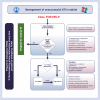Difficult Airway Society guidelines for awake tracheal intubation (ATI) in adults
- PMID: 31729018
- PMCID: PMC7078877
- DOI: 10.1111/anae.14904
Difficult Airway Society guidelines for awake tracheal intubation (ATI) in adults
Abstract
Awake tracheal intubation has a high success rate and a favourable safety profile but is underused in cases of anticipated difficult airway management. These guidelines are a comprehensive document to support decision making, preparation and practical performance of awake tracheal intubation. We performed a systematic review of the literature seeking all of the available evidence for each element of awake tracheal intubation in order to make recommendations. In the absence of high-quality evidence, expert consensus and a Delphi study were used to formulate recommendations. We highlight key areas of awake tracheal intubation in which specific recommendations were made, which included: indications; procedural setup; checklists; oxygenation; airway topicalisation; sedation; verification of tracheal tube position; complications; management of unsuccessful awake tracheal intubation; post-tracheal intubation management; consent; and training. We recognise that there are a range of techniques and regimens that may be effective and one such example technique is included. Breaking down the key practical elements of awake tracheal intubation into sedation, topicalisation, oxygenation and performance might help practitioners to plan, perform and address complications. These guidelines aim to support clinical practice and help lower the threshold for performing awake tracheal intubation when indicated.
Keywords: airway management; bronchoscopy; laryngoscopy; tracheal intubation; training; videolaryngoscopy.
© 2019 The Authors. Anaesthesia published by John Wiley & Sons Ltd on behalf of Association of Anaesthetists.
Figures




Comment in
-
From variance to guidance for awake tracheal intubation.Anaesthesia. 2020 Apr;75(4):442-446. doi: 10.1111/anae.14947. Epub 2019 Dec 11. Anaesthesia. 2020. PMID: 31828761 No abstract available.
-
Difficult Airway Society guidelines for awake tracheal intubation in adults.Anaesthesia. 2020 May;75(5):688. doi: 10.1111/anae.14969. Anaesthesia. 2020. PMID: 32557546 No abstract available.
-
Difficult Airway Society guidelines for awake tracheal intubation in adults - is lidocaine topicalisation safe?Anaesthesia. 2020 Sep;75(9):1259-1260. doi: 10.1111/anae.15051. Epub 2020 Jun 24. Anaesthesia. 2020. PMID: 32578189 No abstract available.
-
A decade of using a remifentanil target-controlled infusion technique for awake fibreoptic intubations.Anaesthesia. 2021 Feb;76(2):284-285. doi: 10.1111/anae.15226. Epub 2020 Aug 1. Anaesthesia. 2021. PMID: 32737983 No abstract available.
References
-
- Cook TM, Woodall NM, Frerk CM. 4th National Audit Project of the Royal College of Anaesthetists and the Difficult Airway Society. British Journal of Anaesthesia 2011; 106: 617–31. - PubMed
-
- Petrini F, Accorsi A, Adrario E, et al. Recommendations for airway control and difficult airway management. Minerva Anestesiologica 2005; 71: 617–57. - PubMed
-
- Australian and New Zealand College of Anaesthetists . Guidelines for the management of evolving airway obstruction: transition to the can't intubate can't oxygenate airway emergency. Australian and New Zealand College of Anaesthetists (ANZCA) 2016.; 2016.
Publication types
MeSH terms
LinkOut - more resources
Full Text Sources
Other Literature Sources
Medical

